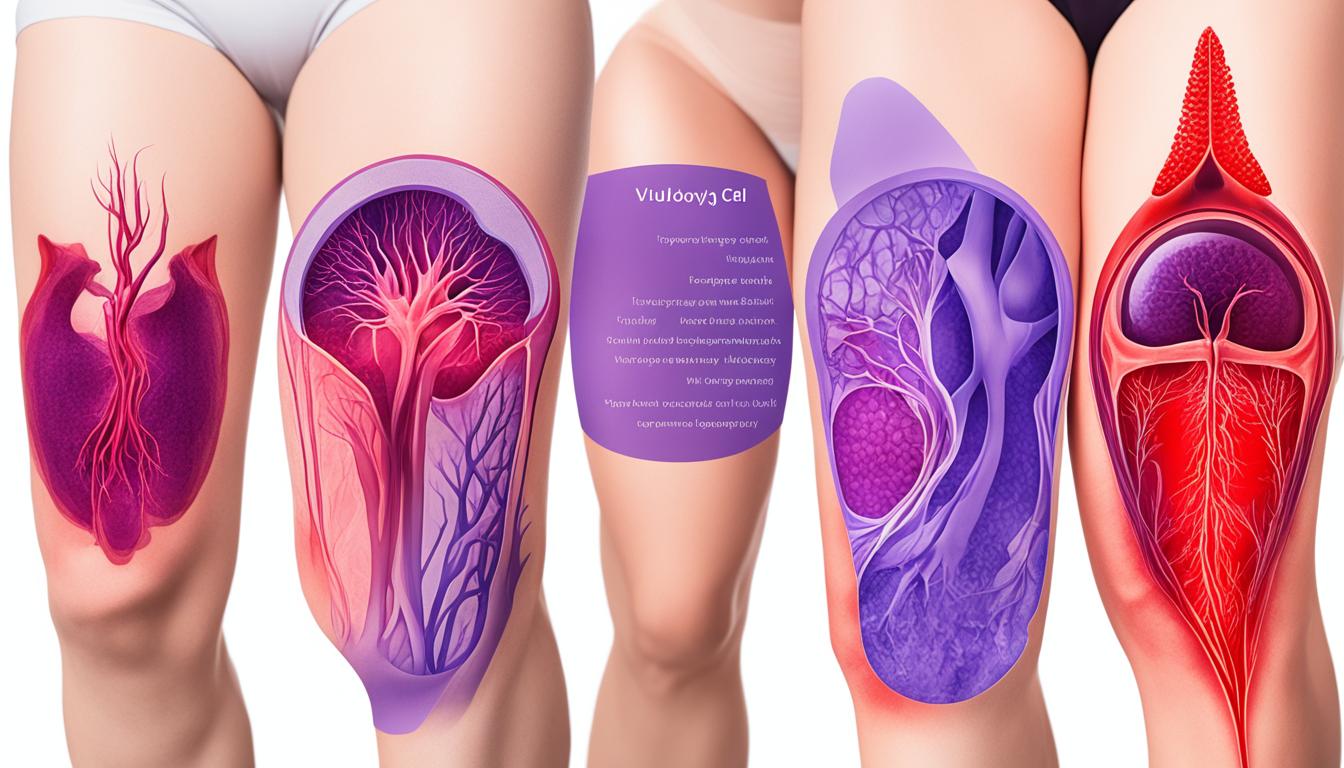Vulvodynia is a condition known for causing persistent pain and discomfort in the vulva. Its exact cause is a mystery, but it seems to be complex. This condition makes it hard for doctors to diagnose because there are no specific tests to show it. Women who have vulvodynia often experience burning, stinging, itching, and soreness in their vulva. These symptoms can make life and sex difficult. Studies vary, but it’s thought between 1.3% to 28% of women may have it. Yet, many find it hard to get a correct diagnosis.
Treatments for vulvodynia often combine many approaches. This can include drugs, creams, physical therapy, and counseling. One new potential treatment is stem cell therapy. Although still in the early research phase, stem cells may offer hope for reducing pain for a long time.
Key Takeaways:
- Vulvodynia is a condition characterized by persistent vulvar pain and discomfort.
- The exact cause of vulvodynia is unknown, but it is believed to involve multiple factors.
- Common symptoms of vulvodynia include burning, stinging, itching, and soreness in the vulva.
- Treatment for vulvodynia may include medications, topical treatments, physical therapy, and psychological interventions.
- Stem cell therapy is an emerging treatment option that shows promise in managing vulvar pain and providing long-lasting relief.
What is Vulvodynia?
Vulvodynia is a gynecological condition that causes chronic pain, soreness, and burning in the vulva. The vulva is the external genital area of a woman. This can lead to significant discomfort and affect daily life greatly.
Diagnosing vulvodynia involves ruling out other causes of pain like infections or inflammation. It is a complex condition with many possible triggers. Some factors linked to vulvodynia include irritants, previous HPV infection, and autoimmune diseases.
One major effect of vulvodynia is its impact on sexual health and overall quality of life. Women with vulvodynia often have painful sex. It may lower sexual desire and lead to difficulties with arousal.
It’s important to distinguish vulvodynia from other vulvar conditions. A full medical evaluation is necessary. This includes a detailed history and pelvic exam, plus sometimes further tests.
While managing vulvodynia can be tough, there are many treatment options. Pain can be managed with creams, medications, therapy, and psychological help. Currently, researchers are looking at stem cell therapy for a possible longer-term solution.
Stem cell therapy aims to use the patient’s stem cells to repair the vulvar tissue and reduce inflammation. This is a new approach that, while promising, requires more research to confirm its benefits.
| Key Points |
|---|
| Vulvodynia is a gynecological condition characterized by chronic pain, soreness, and burning in the vulva. |
| The pain can be localized or more widespread and is usually diagnosed by ruling out other potential causes. |
| Vulvodynia can have various triggers and underlying causes, including irritants, previous HPV infection, oral contraceptive use, vaginal candidiasis, psychological factors, and autoimmune diseases. |
| It can significantly impact a woman’s sexual functioning and overall quality of life. |
| Treatment options include pain management techniques, such as topical treatments, medications, physical therapy, and psychological interventions. |
| Stem cell therapy is an emerging treatment option that shows promise in providing long-lasting pain relief for vulvodynia. |
Incidence and Diagnosis of Vulvodynia
Vulvodynia, a common but often missed condition, affects between 1.3% and 28% of women. Pinpointing its exact rate is tough due to misdiagnosis and underreporting. Many women face a long, frustrating path to a diagnosis. This is worsened by doctors who might not know enough about the condition.
Doctors look for chronic vulvar pain for at least three months with no clear cause. They use a process of elimination. This helps rule out other issues. Patients may have a detailed medical history taken and undergo various tests to find the cause.
It’s vital for healthcare providers to know about vulvodynia. They must support women searching for a diagnosis. By spreading the word about this condition, doctors can help ensure timely and accurate diagnoses. This helps women get the care they need.
Vulvodynia Diagnosis Process:
- Comprehensive medical history to assess symptoms, duration, and potential triggers.
- Pelvic examination to observe any signs of inflammation, infection, or skin abnormalities.
- Evaluation of potential causes through ruling out other conditions with similar symptoms.
- Additional tests, such as cultures or biopsies, if necessary to confirm the absence of other underlying health issues.
Healthcare providers use a specific process to diagnose vulvodynia. This includes taking a detailed medical history and performing various tests. By following these steps, they ensure an accurate diagnosis. This allows women to receive the right care and support.
Advances in Stem Cell Therapy for Vulvodynia
Stem cell therapy shows promise in treating vulvodynia, a condition with severe pain in the vulva. It works by using stem cells to repair damaged tissue. This can help manage pain and promote healing in patients.
Early research on stem cell therapy for this condition is showing hope. It involves taking stem cells from the patient’s own body. This is often from fat tissue. Then, the stem cells are prepared and injected back into the vulvar area. This helps the tissue to heal and reduces swelling.
Studies suggest stem cell therapy might offer long-term pain relief and symptom improvement. But, more research is still necessary to understand exactly how it works. Even so, stem cell therapy is seen as a potentially big breakthrough in the treatment of vulvodynia. It could significantly improve pain management and bring hope to those who suffer from the condition.

